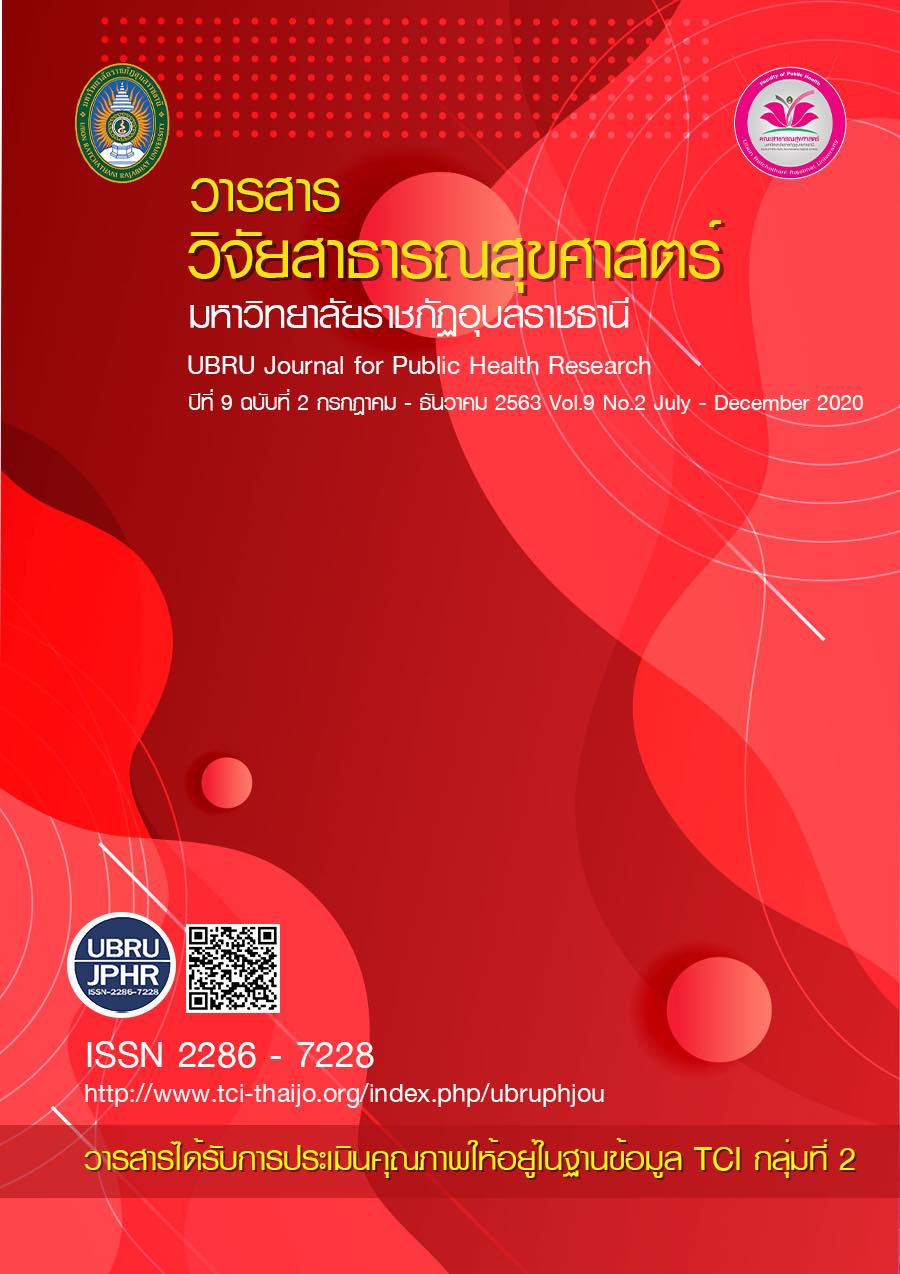Forecasting Model to Predict the Incidence Number of Dengue Cases in Ubon Ratchatani Province, Thailand
Keywords:
Dengue fever, Model Holt-Winter, Model Box-JenkinsAbstract
Abstract
This study aimed to determine the best model for forecasting the Dengue incidence number in the Ubon Ratchathani province. A comparison between Holt-Winter and Box-Jenkins technique was considered. This study collected data of all types of dengue fever from 2008 to 2018. In developing the model, a data size of 120 was used, whereas a data size of 12 was used for the validation.
The results showed that the ARIMA (0,1,0). SARIMA (0,1,0) was the best forecasting model of the Box and Jenkins technique. The MSE, MAPE, and RMSE values of the model development were 90.66, 252.95, and 127.77 respectively, and the validating step was 107.50, 54.72, and 169.36 respectively. But, it higher than the Holt-Winter technique which has the MSE, MAPE, and RMSE values of the model development were 53.88, 124.59, and 85.26 respectively, and the validating step was 107.50, 54.72, and 169.36 respectively. From the forecast of the number of dengue fever patients in 2019. We found that the tends to be epidemic is likely since the beginning of the year. The number of dengue patients was higher than the median value of the past 5 years' observations. The highest spread of the dengue fever was in May-August 2019.
In conclusion, the Holt-Winter was the best forecasting model to predict the Incidence Number of Dengue Cases in Ubon Ratchatani Province. However, the local public health officers should plan to monitor and prevent dengue fever and have intensive control of the disease in May-August 2019.
Keywords: Dengue fever, Model Holt-Winter, Model Box-Jenkins
References
กมล กัญญาประสิทธิ์. (2559). การพยากรณ์การเกิดโรคไข้เลือดออกมนพื้นที่จังหวัดเพชรบูรณ์ พ.ศ. 2558. วารสารวิชาการสาธารณสุข. 25(4), 604-14.
กลุ่มระบาดวิทยาโรคติดต่อ กรมควบคุมโรค. (2560). ไข้เลือดออก. กรุงเทพฯ: กลุ่มระบาดวิทยาโรคติดต่อ กรมควบคุมโรค.
ชญามิน บุญมานะและนัท กุลวานิช.(2560). การเปรียบเทียบความแม่นยำของการพยากรณ์ด้วยตัวแบบอนุกรมเวลาแบบผสม. วารสารวิทยาศาสตร์และเทคโนโลยี. 25(2), 177-190.
ชาญชัยณรงค์ ทรงคาศรี. (2555). รูปแบบการพยากรณ์โรคไข้เลือดออกในพื้นที่สำนักงานป้องกันควบคุมโรคที่ 6 จังหวัดขอนแก่น พ.ศ. 2555. วารสารสำนักงานป้องกันควบคุมโรคที่ 6 จังหวัดขอนแก่น. 20(1), 65-81.
ทรงศิริ แต้สมบัติ. (2549). เทคนิคการพยากรณ์เชิงปริมาณ. กรุงเทพมหานคร: ฟิสิกส์เซ็นเตอร์.
ศุขธิดา อุบล. (2549). ไข้เลือดออกเด็งกี่: ไวรัสวิทยา พยาธิกำเนิดจากกลไกภูมิคุ้มกัน การวินิจฉัย การดูแลรักษา วัคซีน การป้องกันและควบคุม. กรุงเทพมหานคร: หมอชาวบ้าน.
สำนักงานสาธารณสุขจังหวัดอุบลราชธานี. (2561). สถานการณ์ไข้เลือดออกรายสัปดาห์ จังหวัดอุบลราชธานี. อุบลราชธานี: สำนักงานสาธารณสุขจังหวัดอุบลราชธานี.
สุพรรณี อึ้งปัญสัตวงศ์. (2555). เทคนิคการพยากรณ์เชิงสถิติ. ขอนแก่น: ขอนแก่น: มหาวิทยาลัยขอนแก่น.
Coker, R. J., Hunter, B. M., Rudge, J. W., Liverani, M., & Hanvoravongchai, P. (2011). Emerging infectious diseases in southeast Asia: regional challenges to control. The Lancet, 377(9765), 599–609.
Downloads
Published
How to Cite
Issue
Section
License
Copyright (c) 2020 คณะสาธารณสุขศาสตร์ มหาวิทยาลัยราชภัฏอุบลราชธานี

This work is licensed under a Creative Commons Attribution-NonCommercial-NoDerivatives 4.0 International License.
เนื้อหาและข้อมูลในบทความที่ลงตีพิมพ์ในวารสารวารสารวิจัยสาธารณสุขศาสตร์ มหาวิทยาลัยราชภัฏอุบลราชธานี ถือเป็นข้อคิดเห็นและความรับผิดชอบของผู้เขียนบทความโดยตรงซึ่งกองบรรณาธิการวารสาร ไม่จำเป็นต้องเห็นด้วย หรือร่วมรับผิดชอบใดๆ
บทความ ข้อมูล เนื้อหา รูปภาพ ฯลฯ ที่ได้รับการตีพิมพ์ในวารสารนี้ ถือเป็นลิขสิทธิ์ของวารสารฯ หากบุคคลหรือหน่วยงานใดต้องการนำทั้งหมดหรือส่วนหนึ่งส่วนใดไปเผยแพร่ต่อหรือเพื่อกระทำการใดๆ จะต้องได้รับอนุญาตเป็นลายลักอักษรณ์จากบรรณาธิการวารสารนี้ก่อนเท่านั้น


